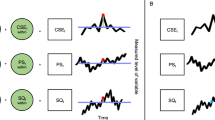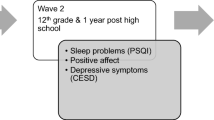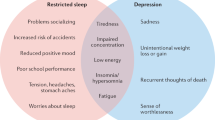Abstract
Depression is a common and debilitating disorder in adolescence. Sleep disturbances and depression often co-occur with sleep disturbances frequently preceding depression. The current study investigated whether catastrophic worry, a potential cognitive vulnerability, mediates the relationship between adolescent sleep disturbances and depressive symptoms, as well as whether there are gender differences in this relationship. High school students, ages 16–18, n = 1,760, 49 % girls, completed annual health surveys including reports of sleep disturbance, catastrophic worry, and depressive symptoms. Sleep disturbances predicted depressive symptoms 1-year later. Catastrophic worry partially mediated the relationship. Girls reported more sleep disturbances, depressive symptoms, and catastrophic worry relative to boys. The results, however, were similar regardless of gender. Sleep disturbances and catastrophic worry may provide school nurses, psychologists, teachers, and parents with non-gender specific early indicators of risk for depression. Several potentially important practical implications, including suggestions for intervention and prevention programs, are highlighted.



Similar content being viewed by others
References
Abela, J. R. Z., & Hankin, B. L. (2008). Cognitive vulnerability to depression in children and adolescents: A developmental psychopathology perspective. In J. R. Z. Abela & B. L. Hankin (Eds.), Handbook of depression in children and adolescents (pp. 35–78). New York: Guilford Press.
American Psychiatric Association. (2000). Diagnostic and statistical manual of mental disorders (4th ed., text rev. ed.). Washington, DC: Author.
Baron, R. M., & Kenny, D. A. (1986). The moderator-mediator variable distinction in social psychological research: Conceptual, strategic and statistical considerations. Journal of Personality and Social Psychology, 51, 1173–1182. doi:10.1037/0022-3514.51.6.1173.
Benca, R. M., & Peterson, M. J. (2008). Insomnia and depression. Sleep Medicine, 9(Supplement 1), S3–S9. doi:10.1016/s1389-9457(08)70010-8.
Blunden, S. L., & Chervin, R. D. (2008). Sleep problems are associated with poor outcomes in remedial teaching programmes: A preliminary study. Journal of Paediatrics and Child Health, 44, 237–242. doi:10.1111/j.1440-1754.2007.01237.x.
Buysse, D. J., Angst, J., Gamma, A., Ajdacic, V., Eich, D., & Rössler, W. (2008). Prevalence, course, and comorbidity of insomnia and depression in young adults. Sleep, 31, 473–480.
Carskadon, M., Acebo, C., & Jenni, O. (2004). Regulation of adolescent sleep: Implications for behavior. Annals of the New York Academy of Sciences, 1021, 276–291. doi:10.1196/annals.1308.032.
Carskadon, M., Wolfson, A., Acebo, C., Tzischinsky, O., & Seifer, R. (1998). Adolescent sleep patterns, circadian timing, and sleepiness at a transition to early school days. Sleep, 21, 871–881.
Clark, D. A., Beck, A. T., & Alford, B. A. (1999). Scientific foundations of cognitive theory and therapy of depression. New York: Wiley.
Clarke, G. N., Hornbrook, M., Lynch, F., Polen, M., Gale, J., Beardslee, W., et al. (2001). A randomized trial of a group cognitive intervention for preventing depression in adolescent offspring of depressed parents. Archives of General Psychiatry, 58, 1127–1134. doi:10.1001/archpsyc.58.12.1127.
Dagys, N., McGlinchey, E. L., Talbot, L. S., Kaplan, K. A., Dahl, R. E., & Harvey, A. G. (2012). Double trouble? The effects of sleep deprivation and chronotype on adolescent affect. Journal of Child Psychology and Psychiatry, 53, 660–667. doi:10.1111/j.1469-7610.2011.02502.x.
Davey, G. C. L., & Levy, S. (1998). Catastrophic worrying: Personal inadequacy and a perseverative iterative style as features of the catastrophizing process. Journal of Abnormal Psychology, 107, 576–586. doi:10.1037/0021-843X.107.4.576.
Dozois, D. J. A., & Beck, A. T. (2008). Cognitive schemas, beliefs, and assumptions. In K. S. Dobson & D. J. A. Dozois (Eds.), Risk factors in depression (pp. 121–143). San Diego, CA: Elsevier Academic Press.
Essau, C. A., Lewinsohn, P. M., Seeley, J. R., & Sasagawa, S. (2010). Gender differences in the developmental course of depression. Journal of Affective Disorders, 127, 185–190. doi:10.1016/j.jad.2010.05.016.
Fallone, G., Owens, J. A., & Deane, J. (2002). Sleepiness in children and adolescents: Clinical implications. Sleep Medicine Reviews, 6, 287–306. doi:10.1053/smrv.2001.0192.
Fletcher, J. M. (2010). Adolescent depression and educational attainment: Results using sibling fixed effects. Health Economics, 19, 855–871. doi:10.1002/hec.1526.
Flouri, E., & Panourgia, C. (2011). Gender differences in the pathway from adverse life events to adolescent emotional and behavioural problems via negative cognitive errors. British Journal of Developmental Psychology, 29, 234–252. doi:10.1348/0261-510X.002002.
Franzen, P. L., & Buysse, D. J. (2008). Sleep disturbances and depression: Risk relationships for subsequent depression and therapeutic implications. Dialogues in Clinical Neuroscience, 10(4), 473–481.
Garnefski, N., Legerstee, J., Kraaij, V., van den Kommer, T., & Teerds, J. (2002). Cognitive coping strategies and symptoms of depression and anxiety: A comparison between adolescents and adults. Journal of Adolescence, 25, 603–611. doi:10.1006/jado.2002.0507.
Garnefski, N., Teerds, J., Kraaij, V., Legerstee, J., & van den Kommer, T. (2004). Cognitive emotion regulation strategies and depressive symptoms: Differences between males and females. Personality and Individual Differences, 36, 267–276. doi:10.1016/S0191-8869(03)00083-7.
Giaconia, R. M., Reinherz, H. Z., Silverman, A. B., Pakiz, B., Frost, A. K., & Cohen, E. (1994). Ages of onset of psychiatric disorders in a community population of older adolescents. Journal of the American Academy of Child and Adolescent Psychiatry, 33, 706–717. doi:10.1097/00004583-199406000-00012.
Gilbert, K. E. (2012). The neglected role of positive emotion in adolescent psychopathology. Clinical Psychology Review, 32, 467–481. doi:10.1016/j.cpr.2012.05.005.
Gradisar, M., Gardner, G., & Dohnt, H. (2011). Recent worldwide sleep patterns and problems during adolescence: A review and meta-analysis of age, region, and sleep. Sleep Medicine, 12, 110–118. doi:10.1016/j.sleep.2010.11.008.
Gregory, A. M., & Sadeh, A. (2011). Sleep, emotional and behavioral difficulties in children and adolescents. Sleep Medicine Reviews, 16, 129–136. doi:10.1016/j.smrv.2011.03.007.
Hammen, C., Brennan, P. A., Keenan Miller, D., & Herr, N. R. (2008). Early onset recurrent subtype of adolescent depression: Clinical and psychosocial correlates. Journal of Child Psychology and Psychiatry, 49, 433–440. doi:10.1111/j.1469-7610.2007.01850.x.
Hankin, B. L., Abramson, L. Y., Moffitt, T. E., Silva, P. A., McGee, R., & Angell, K. E. (1998). Development of depression from preadolescence to young adulthood: Emerging gender differences in a 10-year longitudinal study. Journal of Abnormal Psychology, 107, 128. doi:10.1037/0021-843X.107.1.128.
Harvey, A. G., Murray, G., Chandler, R. A., & Soehner, A. (2011). Sleep disturbance as transdiagnostic: Consideration of neurobiological mechanisms. Clinical Psychology Review, 31, 225–235. doi:10.1016/j.cpr.2010.04.003.
Harvey, A. G., Watkins, E., Mansell, W., & Shafran, R. (2004). Cognitive behavioural processes across psychological disorders: A transdiagnostic approach to research and treatment. New York: Oxford University Press.
Hasler, G., Pine, D., Kleinbaum, D., Gamma, A., Luckenbaugh, D., Ajdacic, V., et al. (2005). Depressive symptoms during childhood and adult obesity: The Zurich Cohort Study. Molecular psychiatry, 10, 842–850. doi:10.1038/sj.mp.4001671.
Hayes, A. F. (2009). Beyond Baron and Kenny: Statistical mediation analysis in the new millennium. Communication Monographs, 76, 408–420. doi:10.1080/03637750903310360.
Hilt, L., McLaughlin, K., & Nolen-Hoeksema, S. (2010). Examination of the response styles theory in a community sample of young adolescents. Journal of Abnormal Child Psychology, 38, 545–556. doi:10.1007/s10802-009-9384-3.
Holmbeck, G. N. (1997). Toward terminological, conceptual, and statistical clarity in the study of mediators and moderators: Examples from the child-clinical and pediatric psychology literatures. Journal of Consulting and Clinical Psychology, 65, 599–610. doi:10.1037/0022-006X.65.4.599.
Hudziak, J. J., Achenbach, T. M., Althoff, R. R., & Pine, D. S. (2007). A dimensional approach to developmental psychopathology. International journal of methods in psychiatric research, 16, S16–S23. doi:10.1002/mpr.217.
Jaffee, S. R., Harrington, H., Cohen, P., & Moffitt, T. E. (2005). Cumulative prevalence of psychiatric disorder in youths. Journal of the American Academy of Child and Adolescent Psychiatry, 44, 406–407. doi:10.1097/01.chi.0000155317.38265.61.
Johnson, E. O., Roth, T., & Breslau, N. (2006a). The association of insomnia with anxiety disorders and depression: Exploration of the direction of risk. Journal of Psychiatric Research, 40, 700–708. doi:10.1016/j.jpsychires.2006.07.008.
Johnson, E. O., Roth, T., Schultz, L., & Breslau, N. (2006b). Epidemiology of DSM-IV insomnia in adolescence: Lifetime prevalence, chronicity, and an emergent gender difference. Pediatrics, 117, 247–256. doi:10.1542/peds.2004-2629.
Keenan-Miller, D., Hammen, C. L., & Brennan, P. A. (2007). Health outcomes related to early adolescent depression. Journal of Adolescent Health, 41, 256–262. doi:10.1016/j.jadohealth.2007.03.015.
Kenny, D. A. (2011). SPSS macro MedText. Written by David A. Kenny, Department of Psychology, University of Connecticut.
Kessler, R. C., Avenevoli, S., & Merikangas, K. R. (2001). Mood disorders in children and adolescents: An epidemiologic perspective. Biological Psychiatry, 49, 1002–1014. doi:10.1016/S0006-3223(01)01129-5.
Kessler, R. C., Berglund, P., Demler, O., Jin, R., Merikangas, K. R., & Walters, E. E. (2005). Lifetime prevalence and age-of-onset distributions of DSM-IV disorders in the National Comorbidity Survey Replication. Archives of General Psychiatry, 62, 593–602.
Liu, X., Buysse, D. J., Gentzler, A. L., Kiss, E., Mayer, L., Kapornai, K., et al. (2007). Insomnia and hypersomnia associated with depressive phenomenology and comorbidity in childhood depression. Sleep, 30, 83–90.
Lundh, L. G., Bjärehed, J., & Wångby-Lundh, M. (2012). Poor sleep as a risk factor for nonsuicidal self-injury in adolescent girls. Journal of Psychopathology and Behavioral Assessment, Advance online publication,. doi:10.1007/s10862-012-9307-4.
MacDonald, S., Linton, S. J., & Jansson-Fröjmark, M. (2008). Avoidant safety behaviors and catastrophizing: Shared cognitive-behavioral processes and consequences in co-morbid pain and sleep disorders. International Journal of Behavioral Medicine, 15, 201–210. doi:10.1080/10705500802222675.
MacGregor, K. L., Funderburk, J. S., Pigeon, W., & Maisto, S. A. (2012). Evaluation of the PHQ-9 item 3 as a screen for sleep disturbance in primary care. Journal of General Internal Medicine, 27, 339–344. doi:10.1007/s11606-011-1884-5.
Manber, R., & Chambers, A. S. (2009). Insomnia and depression: A multifaceted interplay. Current Psychiatry Reports, 11, 437–442. doi:10.1007/s11920-009-0066-1.
Mansell, W., Harvey, A., Watkins, E. R., & Shafran, R. (2008). Cognitive behavioral processes across psychological disorders: A review of the utility and validity of the transdiagnostic approach. International Journal of Cognitive Therapy, 1, 181–191. doi:10.1521/ijct.2008.1.3.181.
Merikangas, K. R., He, J., Burstein, M., Swanson, S. A., Avenevoli, S., Cui, L., et al. (2010). Lifetime prevalence of mental disorders in US adolescents: Results from the National Comorbidity Survey Replication-Adolescent Supplement (NCS-A). Journal of the American Academy of Child and Adolescent Psychiatry, 49, 980–989. doi:10.1016/j.jaac.2010.05.017.
Nesse, R. M., & Ellsworth, P. C. (2009). Evolution, emotions, and emotional disorders. American Psychologist, 64, 129–139. doi:10.1037/a0013503.
O’Connell, M. E., Boat, T. F., & Warner, K. E. (Eds.). (2009). Preventing mental, emotional, and behavioral disorders among young people: Progress and possibilities. Washington, DC: National Academies Press.
Ohayon, M. M. (2002). Epidemiology of insomnia: What we know and what we still need to learn. Sleep Medicine Reviews, 6, 97–111. doi:10.1053/smrv.2002.0186.
Ohayon, M. M. (2005). Prevalence and correlates of nonrestorative sleep complaints. Archives of Internal Medicine, 165, 35–41. doi:10.1001/archinte.165.1.35.
Ohayon, M. M., Shapiro, C. M., & Kennedy, S. H. (2000). Differentiating DSM-IV anxiety and depressive disorders in the general population: Comorbidity and treatment consequences. The Canadian Journal of Psychiatry/La Revue canadienne de psychiatrie, 45, 166–172.
Olsson, G., & Von Knorring, A. L. (1997). Depression among Swedish adolescents measured by the self rating scale Center for Epidemiology Studies-Depression Child (CES-DC). European Child and Adolescent Psychiatry, 6, 81–87. doi:10.1007/BF00566670.
Preacher, K. J., & Hayes, A. F. (2004). SPSS and SAS procedures for estimating indirect effects in simple mediation models. Behavior Research Methods, 36, 717–731. doi:10.3758/BF03206553.
Preacher, K. J., & Hayes, A. F. (2008). Asymptotic and resampling strategies for assessing and comparing indirect effects in multiple mediator models. Behavior Research Methods, 40, 879–891. doi:10.3758/BRM.40.3.879.
Rao, U. (2006a). Development and natural history of pediatric depression: Treatment implications. Clinical Neuropsychiatry: Journal of Treatment Evaluation, 3, 194–204.
Rao, U. (2006b). Links between depression and substance abuse in adolescents: Neurobiological mechanisms. American Journal of Preventive Medicine, 31(Supplement 1), 161–174. doi:10.1016/j.amepre.2006.07.002.
Rao, U., & Chen, L. A. (2009). Characteristics, correlates, and outcomes of childhood and adolescent depressive disorders. Dialogues in clinical neuroscience, 11, 45–62.
Riskind, J. H., & Alloy, L. B. (2006). Cognitive vulnerability to psychological disorders: Overview of theory, design, and methods. Journal of Social and Clinical Psychology, 25, 705–725. doi:10.1521/jscp.2006.25.7.705.
Roane, B. M., & Taylor, D. J. (2008). Adolescent insomnia as a risk factor for early adult depression and substance abuse. Sleep, 31, 1351–1356.
Roberts, R. E., Roberts, C. R., & Chen, I. G. (2002). Impact of insomnia on future functioning of adolescents. Journal of Psychosomatic Research, 53, 561–569. doi:10.1016/S0022-3999(02)00446-4.
Rohde, P., Lewinsohn, P. M., & Seeley, J. R. (1994). Are adolescents changed by an episode of major depression? Journal of the American Academy of Child and Adolescent Psychiatry, 33, 1289–1298. doi:10.1097/00004583-199411000-00010.
Roth, T., Jaeger, S., Jin, R., Kalsekar, A., Stang, P. E., & Kessler, R. C. (2006). Sleep problems, comorbid mental disorders, and role functioning in the national comorbidity survey replication. Biological Psychiatry, 60, 1364–1371. doi:10.1016/j.biopsych.2006.05.039.
Rucker, D. D., Preacher, K. J., Tormala, Z. L., & Petty, R. E. (2011). Mediation analysis in social psychology: Current practices and new recommendations. Social and Personality Psychology Compass, 5, 359–371. doi:10.1111/j.1751-9004.2011.00355.x.
Ruscio, A. M. (2002). Delimiting the boundaries of generalized anxiety disorder: differentiating high worriers with and without GAD. Journal of Anxiety Disorders, 16, 377–400. doi:10.1016/S0887-6185(02)00130-5.
Shrout, P. E., & Bolger, N. (2002). Mediation in experimental and nonexperimental studies: New procedures and recommendations. Psychological Methods, 7, 422–445. doi:10.1037/1082-989X.7.4.422.
Sihvola, E., Keski-Rahkonen, A., Dick, D. M., Pulkkinen, L., Rose, R. J., Marttunen, M., et al. (2007). Minor depression in adolescence: Phenomenology and clinical correlates. Journal of Affective Disorders, 97(1–3), 211–218. doi:10.1016/j.jad.2006.06.019.
Startup, H. M., & Davey, G. C. L. (2001). Mood as input and catatrophic worrying. Journal of Abnormal Psychology, 110, 83. doi:10.1037/0021-843X.110.1.83.
Steinberg, L. (2005). Cognitive and affective development in adolescence. Trends in Cognitive Sciences, 9, 69–74. doi:10.1016/j.tics.2004.12.005.
Sterpenich, V., Albouy, G., Darsaud, A., Schmidt, C., Vandewalle, G., Vu Dang, T. T., et al. (2009). Sleep promotes the neural reorganization of remote emotional memory. Journal of Neuroscience, 29, 5143–5152. doi:10.1523/JNEUROSCI.0561-09.2009.
Tabachnick, B., & Fidell, L. (2007). Using multivariate statistics (5th ed.). Boston, MA: Allyn and Bacon.
Talbot, L. S., McGlinchey, E. L., Kaplan, K. A., Dahl, R. E., & Harvey, A. G. (2010). Sleep deprivation in adolescents and adults: Changes in affect. Emotion, 10, 831–841. doi:10.1037/a0020138.
Taylor, D. J., Lichstein, K. L., Durrence, H. H., Reidel, B. W., & Bush, A. J. (2005). Epidemiology of insomnia, depression, and anxiety. Sleep, 28, 1457–1464.
Taylor, D. J., Mallory, L. J., Lichstein, K. L., Durrence, H., Riedel, B. W., & Bush, A. J. (2007). Comorbidity of chronic insomnia with medical problems. Sleep, 30, 213–218.
van der Helm, E., & Walker, M. P. (2010). The role of sleep in emotional brain regulation. In A. M. Kring & D. M. Sloan (Eds.), Emotion regulation and psychopathology: A transdiagnostic approach to etiology and treatment (pp. 253–279). New York: The Guilford Press.
Van Dongen, H. P. A., Maislin, G., Mullington, J. M., & Dinges, D. F. (2003). The cumulative cost of additional wakefulness: Dose-response effects on neurobiological functions and sleep physiology from chronic restriction and total sleep deprivation. Sleep, 26, 117–126.
Watkins, E. R. (2008). Constructive and unconstructive repetitive thought. Psychological Bulletin, 134, 163–206. doi:10.1037/0033-2909.134.2.163.
Weissman, M. M., Warner, V., Wickramaratne, P., Moreau, D., & Olfson, M. (1997). Offspring of depressed parents: 10 years later. Archives of General Psychiatry, 54, 932–940. doi:10.1001/archpsyc.1997.01830220054009.
Wells, A., & Carter, K. (1999). Preliminary tests of a cognitive model of generalized anxiety disorder. Behaviour Research and Therapy, 37, 585–594. doi:10.1016/S0005-7967(98)00156-9.
Wiebe, S. T., Cassoff, J., & Gruber, R. (2012). Sleep patterns and the risk for unipolar depression: A review. Nature, 4, 63–71. doi:10.2147/NSS.S23490.
Wong, M. M., & Brower, K. J. (2012). The prospective relationship between sleep problems and suicidal behavior in the National Longitudinal Study of Adolescent Health. Journal of Psychiatric Research, 46, 953–959. doi:10.1016/j.jpsychires.2012.04.008.
Yoo, S. S., Gujar, N., Hu, P., Jolesz, F. A., & Walker, M. P. (2007). The human emotional brain without sleep—a prefrontal amygdala disconnect. Current Biology, 17, 877–878. doi:10.1016/j.cub.2007.08.007.
Zlomke, K. R., & Hahn, K. S. (2010). Cognitive emotion regulation strategies: Gender differences and associations to worry. Personality and Individual Differences, 48, 408–413. doi:10.1016/j.paid.2009.11.007.
Acknowledgments
The research in this paper was supported by the pupils and staff at Lindeskolan.
Author information
Authors and Affiliations
Corresponding author
Rights and permissions
About this article
Cite this article
Danielsson, N.S., Harvey, A.G., MacDonald, S. et al. Sleep Disturbance and Depressive Symptoms in Adolescence: The Role of Catastrophic Worry. J Youth Adolescence 42, 1223–1233 (2013). https://doi.org/10.1007/s10964-012-9811-6
Received:
Accepted:
Published:
Issue Date:
DOI: https://doi.org/10.1007/s10964-012-9811-6




